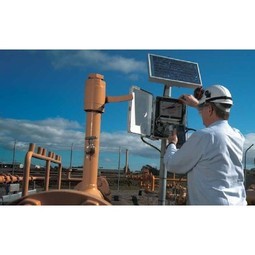Customer Company Size
Large Corporate
Region
- Asia
Country
- Turkey
Product
- ICONICS GENESIS64™ HMI/SCADA suite
- GraphWorX™64
- Hyper Historian™
- AlarmWorX™64 Multimedia
- MobileHMI™
- KPIWorX™
Tech Stack
- Oracle database
- Microsoft SQL Server
- Windows Server 2012 R2
- KEPServerEX Connectivity Platform
Implementation Scale
- Enterprise-wide Deployment
Impact Metrics
- Productivity Improvements
- Cost Savings
Technology Category
- Application Infrastructure & Middleware - Data Exchange & Integration
- Analytics & Modeling - Real Time Analytics
- Functional Applications - Remote Monitoring & Control Systems
Applicable Industries
- Utilities
Applicable Functions
- Maintenance
- Logistics & Transportation
Use Cases
- Remote Asset Management
- Process Control & Optimization
Services
- System Integration
- Software Design & Engineering Services
About The Customer
Aksa Natural Gas Distribution, Inc., headquartered in Istanbul, Turkey, is a natural gas distributor subsidiary of Kazanci Holding, operator of multiple power generation, natural gas distribution, energy generation, and electricity distribution and sales companies throughout Turkey. Aksa operates its natural gas distribution and retail sales activities in 214 districts within 27 Turkish provinces. By the end of 2021, the company increased its total network size to over 34,000 kilometers, its subscriber number to over 4 million, and provided over 11 billion cubic meters of gas distribution.
The Challenge
Aksa Natural Gas Distribution, Inc. sought an automation system for its Natural Gas Regulating and Metering Stations (RMSs), which are divided into three separate types (A, B, C) according to pressure classes. These stations reduce and regulate downstream pressure, measuring the quantity of energy transferred from Aksa’s natural gas transmission system to medium pressure networks or to consumers who are connected directly to the transmission system. They also add the distinctive odor to the gas, providing prompt detection of any leakages, as required by national and international safety standards. Aksa required the stations’ data to be gathered by a central HMI/SCADA system via OPC servers and PLCs. Alarms are generated from critical values within the received data. Aksa required that their selected alarm management system be able to integrate with their RMS system, as well as to provide notifications. The alarm management system needed to handle thousands of tags, with each tag’s status made available to multiple locations, and if necessary, allow for expected intervention within 15 minutes.
The Solution
Aksa Natural Gas Distribution, Inc. selected ICONICS GENESIS64™ HMI/SCADA suite (including GraphWorX™64 advanced visualization), as well as Hyper Historian™ rapid data historian, AlarmWorX™64 Multimedia alarm management system, MobileHMI™ data mobility suite, and KPIWorX™ self-service real-time dashboard tool. The natural gas distributor is now able to remotely monitor and measure data throughout its extensive distribution network, which contains over 120,000 active tags. ICONICS software interfaces with multiple pieces of equipment including Fatek and Motorola Moscad PLCs. As data is transmitted to the central data system, equipment properties are collected into an asset tree, created in Aksa’s preferred hierarchy for use by its operators. Aksa also connects GENESIS64 to its Oracle database, as well as to Microsoft SQL Server, to multiple Windows Server 2012 R2 machines, and to its KEPServerEX Connectivity Platform.
Operational Impact
Quantitative Benefit

Case Study missing?
Start adding your own!
Register with your work email and create a new case study profile for your business.
Related Case Studies.

Case Study
IoT Solutions for Smart City | Internet of Things Case Study
There were several challenges faced: It is challenging to build an appliance that can withstand a wide range of voltage fluctuations from as low at 90v to as high as 320v. Since the device would be installed in remote locations, its resilience was of paramount importance. The device would have to deal with poor network coverage and have the ability to store and re-transmit data if networks were not available, which is often the case in rural India. The device could store up to 30 days of data.

Case Study
Automation of the Oguz-Gabala-Baku water pipeline, Azerbaijan
The Oguz-Gabala-Baku water pipeline project dates back to plans from the 1970’s. Baku’s growth was historically driven by the booming oil industry and required the import of drinking water from outside of the city. Before the construction of the pipeline, some 60 percent of the city’s households received water for only a few hours daily. After completion of the project, 75 percent of the two million Baku residents are now served around the clock with potable water, based on World Health Organization (WHO) standards. The 262-kilometer pipeline requires no pumping station, but uses the altitude differences between the Caucasian mountains and the capital to supply 432,000 m³/d to the Ceyranbatan water reservoir. To the people of Baku, the pipeline is “the most important project not only in 2010, but of the last 20 years.”

Case Study
GPRS Mobile Network for Smart Metering
Around the world, the electricity supply industry is turning to ‘smart’ meters to lower costs, reduce emissions and improve the management of customer supplies. Smart meters collect detailed consumption information and using this feedback consumers can better understand their energy usage which in turn enables them to modify their consumption to save money and help to cut carbon emissions. A smart meter can be defined in many ways, but generally includes an element of two-way communication between the household meter and the utility provider to efficiently collect detailed energy usage data. Some implementations include consumer feedback beyond the energy bill to include online web data, SMS text messages or an information display in consumers’ premises. Providing a cost-effective, reliable communications mechanism is one of the most challenging aspects of a smart meter implementation. In New Zealand, the utilities have embraced smart metering and designed cost effective ways for it to be implemented. The New Zealand government has encouraged such a move to smart metering by ensuring the energy legislation is consistent with the delivery of benefits to the consumer while allowing innovation in this area. On the ground, AMS is a leader in the deployment of smart metering and associated services. Several of New Zealand’s energy retailers were looking for smart metering services for their residential and small business customers which will eventually account for over 500,000 meters when the multi-year national deployment program is concluded. To respond to these requirements, AMS needed to put together a solution that included data communications between each meter and the central data collection point and the solution proposed by Vodafone satisfied that requirement.

Case Study
NB-IoT connected smart meters to improve gas metering in Shenzhen
Shenzhen Gas has a large fleet of existing gas meters, which are installed in a variety of hard to reach locations, such as indoors and underground, meaning that existing communications networks have struggled to maintain connectivity with all meters. The meter success rate is low, data transmissions are so far unstable and power consumption is too high. Against this background, Shenzhen Gas, China Telecom, Huawei, and Goldcard have jointly trialed NB-IoT gas meters to try and solve some of the challenges that the industry faces with today’s smart gas meters.

Case Study
British Gas Modernizes its Operations with Innovative Smart Metering Deployment
The UK government has mandated that smart meters are rolled out as standard across Great Britain by end of 2020, and this roll-out is estimated to create £14 billion in net benefits to the UK in consumer energy savings and lower energy generation demand, according to the Oxford Economics report, “The Value of Smart Metering to Great Britain.” While smart-metering systems have been deployed in many countries, the roll-out in Great Britain is unique because it is led by energy retailers, who have responsibility for the Electricity and Gas meters. The decision to have a retailer-led roll out was made by DECC (Department of Energy and Climate Change) to improve customer experience and drive consumer benefits. It has also led to some unique system-level requirements to support the unique local regulatory model.

Case Study
OneWireless Enabled Performance Guarantee Test
Tata Power's power generation equipment OEMs (M/s BHEL) is required to provide all of the instrumentation and measurement devices for conducting performance guarantee and performance evaluation tests. M/s BHEL faced a number of specific challenges in conducting PG tests: employing high-accuracy digital communications for instrumentation, shortening setup and dismantling time, reducing hardware required, making portable instrument setup, avoiding temporary cabling work and the material waste costs






